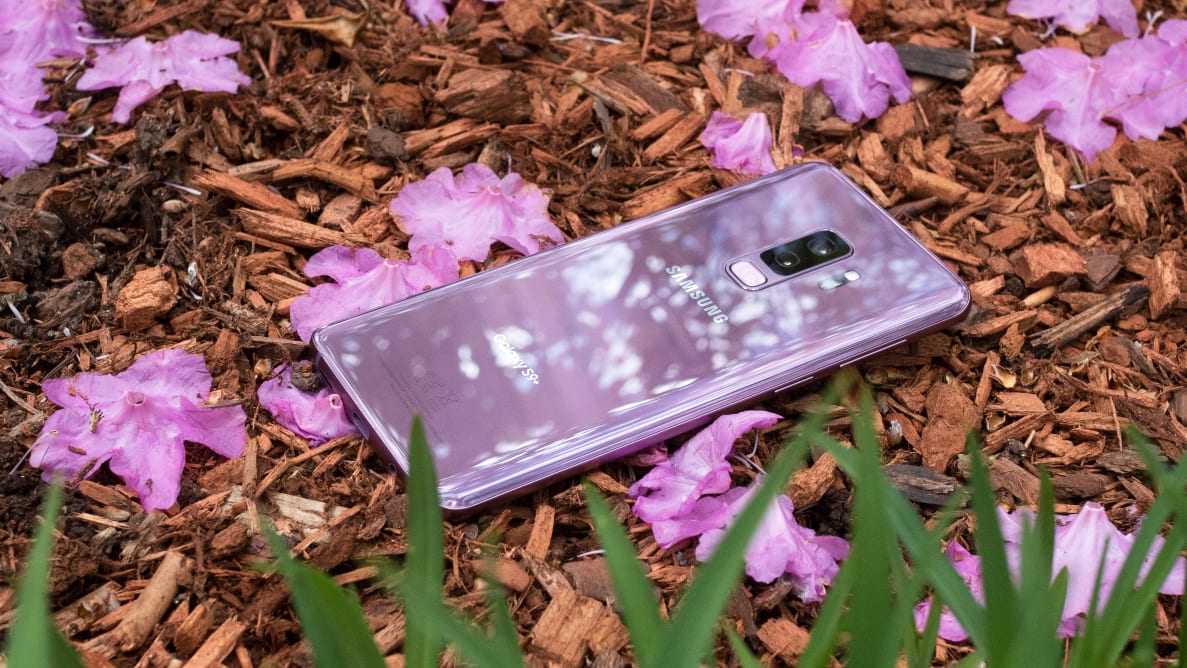Pros
-
Top-of-the-line camera
-
Long battery life
-
A breeze to use
Cons
-
Some unnecessary bloatware
-
Useless virtual assistant
The Samsung Galaxy S9+ is no exception: Its guts—from the camera to the processor—are among the best we’ve seen in a Galaxy phone so far. Hooray! The cycle continues.
We love the S9+. It’s fast, the camera is one of the best on the market, and the phone’s premium build quality has gone through some positive design tweaks since last year’s Galaxy models.
That said, if you’re a proud Galaxy S8 or S8+ owner yearning for something fresh, new, and exciting, you might want to lay low for another year and jump on Samsung’s next offering.
The S9+ is a fantastic smartphone, albeit not one that serves up any surprises. When it comes to the Samsung Galaxy line, however, “more of the same” still adds up to one of the best smartphones you can buy.
About the Samsung Galaxy S9+
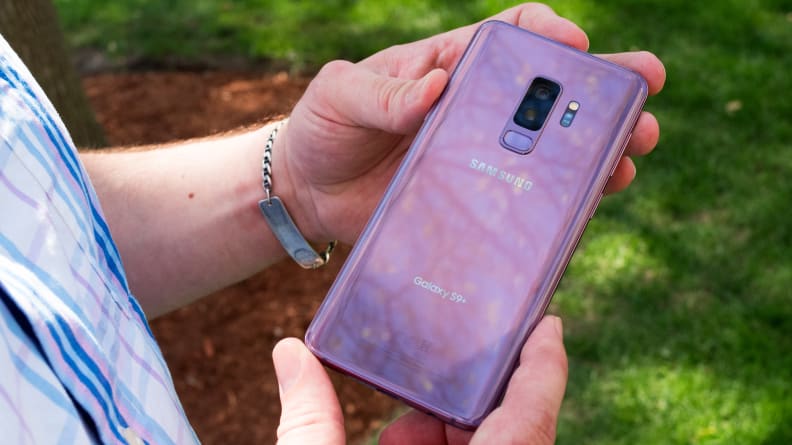
The Galaxy S9+ is the larger of the two newest Galaxy phones from Samsung.
With its 6.2-inch display, the Samsung Galaxy S9+ is the bigger of the two newest Galaxy phones. Thankfully, both the S9 and the S9+ don’t feel quite as big as they are—thanks to Samsung’s deft engineering, the narrowness of each phone makes them feel natural, not cumbersome.
Here’s the S9+ at a glance:
• Snapdragon 845 octa-core processor • 6GB RAM • 64GB internal storage (with 128GB and 256GB storage options starting on May 18), and up to 256GB of expanded storage via microSD • 6.2-inch quad-HD (2960x1440) edge-to-edge AMOLED display • Dual 12MP cameras (f/1.5 - f/2.4 26mm) with 2x optical zoom, OIS, auto-HDR, phase detection autofocus, face detection, 4K video support (60FPS), and 960FPS slow-motion video support @ 720FPS • 8MP f/1.7 front-facing camera • IP68-rated water resistance for up to thirty minutes in 1.5 meters of underwater submersion • 4G LTE, WiFi, AC/Bluetooth, and NFC support (with Samsung Pay) • 3,500mAh lithium-ion battery with both fast and wireless charging • USB Type-C port • Fingerprint, iris, and biometric scanner • 3.5mm headphone jack
One new feature this year is the S9+'s camera lens, which can switch between a f/2.4 aperture and a f/1.5 aperture. It’s something we haven’t seen a smartphone pull off before, and although most people won’t notice the difference between both settings, the development will nevertheless excite shutterbugs who already appreciate Samsung’s top-tier camera experience.
As usual with Samsung's Galaxy lineup, the S9+ features IP68-rated protection against dust and water, which’ll keep your investment intact if you should drop it into the toilet (or another, larger body of water).
What we like about the S9+
Top-notch performance, top-notch battery life
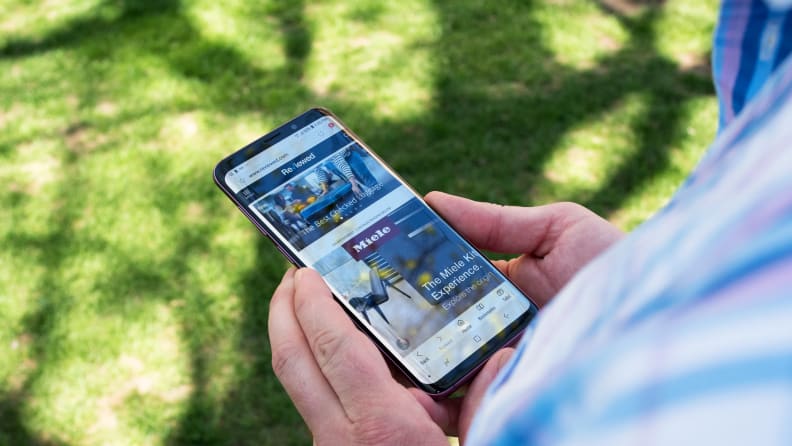
The S9+ gets its name from its huge, 6.2-inch display, but the phone isn't cumbersome to hold, despite its size.
From a hardware standpoint, the Galaxy S9+ isn’t that much different than its predecessor, the S8+, so it makes sense that its overall performance is on roughly the same level, too (which is to say, the highest level money can buy).
Under the hood of the S9+ is a Snapdragon 845 processor (a moderate improvement over the S8+’s Snapdragon 835 processor) and 6GB of RAM. Predictably, the S9+ sailed through our benchmark tests. The hardware, combined with Samsung’s relatively sleek Android skin, makes the day-to-day Galaxy S9+ experience an absolute breeze.
There’s really not much else to say about the S9+ from a performance standpoint—you get what you pay for. To invest in either of Samsung's newest Galaxies is to invest in a smartphone that can handle anything 2018 might throw at it.
The S9+’s battery performance is right in line with what the S8+ and the Note 8 offered a year ago: You can expect all-day coverage, though heavy users might have to plug in before going to sleep if they want to browse the web in bed. In Geekbench's battery test, the S9+ provided over ten hours of nonstop use. This particular test is designed to be hard on the battery—so ten hours is not reflective of average, daily use—but as a yardstick measurement against the competition, it means the S9+'s battery performance is among the best in the game.
We found that the S9+ lasted significantly longer than the S9, which makes sense—the S9+'s 3,500mAh li-on battery is bigger than the S9's 3,000mAh battery. Just something to consider if you're on the fence between the two.
Unsurprisingly, the Galaxy S9+'s camera is fantastic.
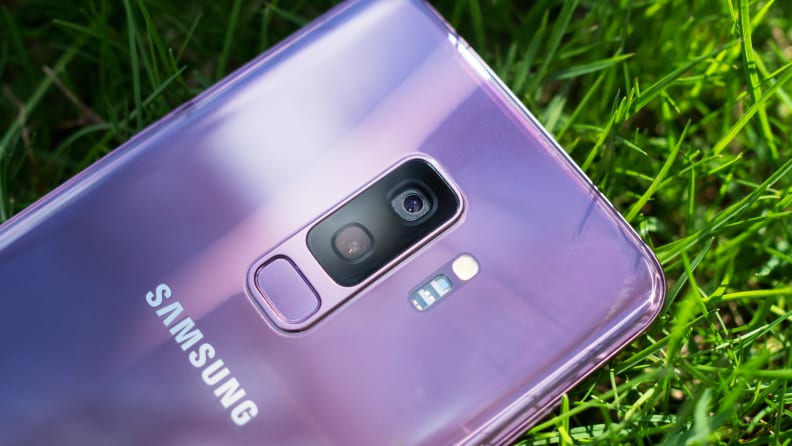
The dual lenses offer one of the best camera experiences in the smartphone game, but the flexibility of having two aperture settings isn't as great as Samsung would have you believe.
Here’s what you need to know about the S9+'s camera: It might be the best smartphone camera available, but it’s not as revelatory as Samsung would have you believe.
Perhaps the most significant upgrade between the S8 generation and the S9 generation is the latter's adjustable camera lens, which can mechanically switch between a f/2.4 and f/1.5 aperture. In theory, the added flexibility allows for a camera that better adapted for changes in environment. In practice, however, the feature is minimally beneficial at best and—in some cases—not useful whatsoever.
In auto mode, Samsung's camera software adjusts itself for dimly lit settings by automatically switching into the f/1.5 aperture. In pro mode, you can switch back and forth manually. Although we found the addition of a second, larger aperture to be mostly unnecessary, there's no reason to be concerned about the camera—the S9+ snaps spectacular photos, just not because of the phone's additional aperture setting.
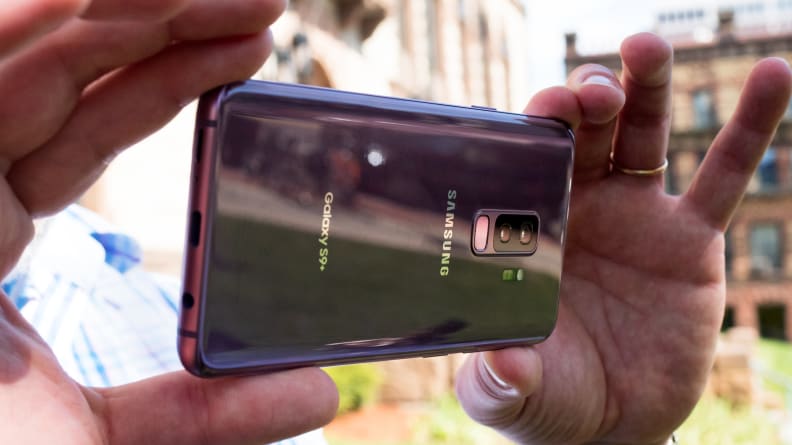
Shooting with the S9+ is a joy.
The S9 and the S9+ continue Samsung's proud tradition of equipping flagship smartphones with bleeding edge camera sensors and imaging software. In our lab's light box, the S9+ performed at a remarkably consistent level regardless of lighting temperatures—photos were mostly free of color pollution brought about by overly warm or cool ambient light.
In low-light settings (like dusk, for example) the S9+ not only reproduces the scene with clarity, but captures moments in a heightened, almost dream-like way. To be fair, it's not that surprising—in recent years, Samsung phones have demonstrated a keen ability for shooting in low-light conditions. To my eyes, however, the S9 took this superlative and upped the ante even more.

The Galaxy S9+ is equipped with one of the best smartphone cameras for low-light conditions.
Like the S8+ and the Note 8 that came before it, the Galaxy S9+ features dual 12MP primary cameras, allowing for 2X optical zoom and a portrait effect similar to the one featured on the iPhone 8 Plus, the iPhone X, and its aforementioned predecessors. None of these phone's produce a background blur as soft and natural as, say, a DSLR, but the feature is nice to have if you're looking to give your subject a little pop.
Along with Google's Pixel 2, the iPhone 8 Plus and the iPhone X, Samsung's newest flagships offer some of the best camera experiences you can get on your smartphone. All of these premium phones produce phenomenal photos—what sets them apart is mostly a matter of subjectivity. I appreciate, for example, the slightly saturated look of Samsung's camera software, but you may find that you prefer the more naturalistic look of photos shot on iPhone.
{{ photo_gallery name="Samsung Galaxy S9+ Sample Photos" fullscreen="true" }}
Both the S9 and the S9+ are also capable of shooting in 4K at up to 60FPS (though you'll probably want a microSD card if you intend on shooting a lot of UHD video) and can even shoot in a super-slow 960 frames per second, but this mode is limited to small bursts at a 720p resolution. Still—it's a neat parlor trick!
The fingerprint scanner is finally where it belongs.
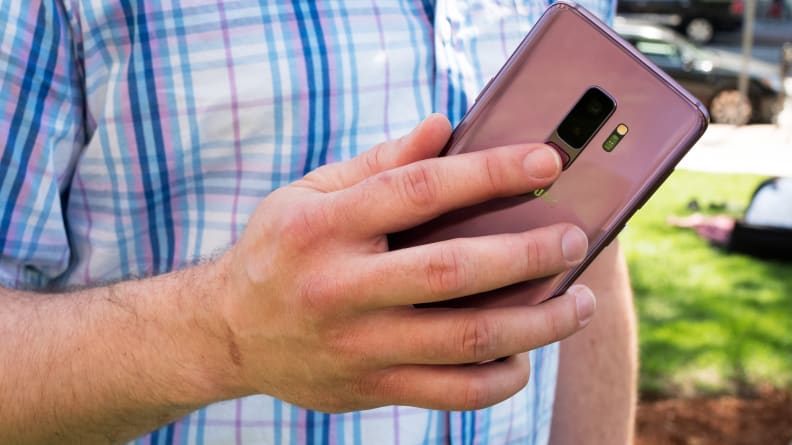
After a couple of generations of the fingerprint scanner being misplaced next to the camera, Samsung wised up and stuck it beneath the camera hump where it belongs.
Ever since Samsung ditched the home button in favor of expanded display real estate, the Galaxy’s fingerprint scanner was relegated to the back of the phone itself.
Unfortunately, the new scanner’s size (similar to the phone’s camera hump) and placement (directly adjacent to the phone’s camera hump) made me (and others) mistakenly try to unlock the phone by pawing at the camera with our fingertips.
This time around, Samsung placed the fingerprint scanner beneath the camera hump, making it the first thing your finger touches when it reaches out from the natural resting position.
I still think that, ideally, the scanner would inhabit its own island separate from the camera internals, but this new placement is much needed improvement.
What we don't like about the S9+
The Bixby button is back—and still basically useless.
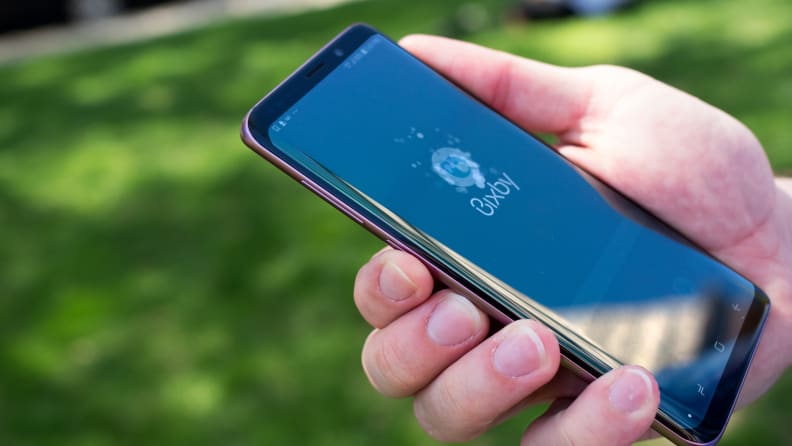
I've yet to find a worthwhile application for the Bixby personal assistant.
I think we can officially put a fork in Bixby.
Since its initial release, Samsung’s virtual assistant has been a mix of frustrating and yawn-inducing. I’ve been using the S9 and the S9+ for several weeks, and I don’t think I’ve used Bixby more than once or twice. There’s just not much use for it, particularly if you’re already acustomed to using Google Assistant, which is a better-performing and better-integrated assistant.
Like last year’s Galaxy lineup, the S9 and S9+ feature dedicated Bixby buttons just below their respective volume rockers. And, just like last year, the button feels just as superfluous. I don’t necessarily mind the addition of a button, but ideally, it’d be a button I’d actually plan on using once in a while.
Samsung’s pre-loaded software is still a big ol’ drag.
Another year, another pile of bloatware.
We bang this drum with every Galaxy release, but it’s more than a little annoying to sort through a collection of Samsung’s basic software in addition to the far-better selection offered by Google. I’m not sure, for example, that I’ll ever need this copy of Samsung’s “Galaxy Apps” when I have a perfectly good version of Google Play sitting right there in my app drawer.
Should you buy it?
Yes, but only if you're in need of an upgrade.
It’s hard to spend weeks with one of the best smartphones on the market and arrive at the conclusion that you feel somewhat indifferent about it, but I can’t help but feel that way at the moment.
It's true that the newest Samsung Galaxy phones are among the best the industry has to offer at the moment. They aced all of our performance tests, offer a top-of-the-line camera experience, and play the part of a premium phone perfectly when it comes to the look-and-feel factor.
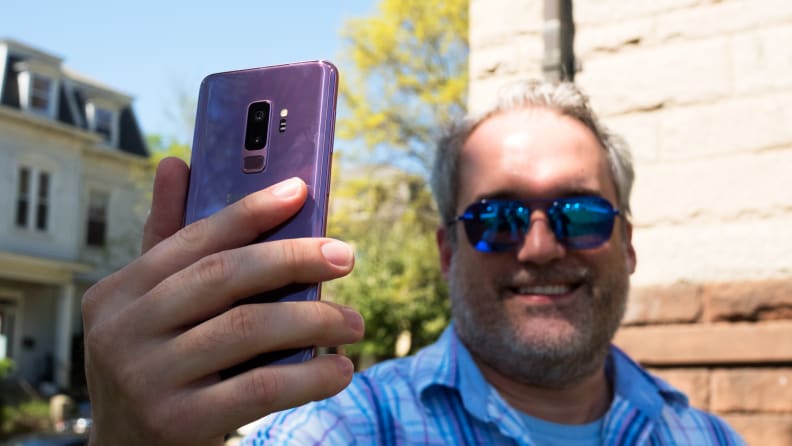
The Galaxy S9+ is a fantastic smartphone and one of the best on the market, but it's probably not going to wow anyone upgrading from an S8 or an S8+.
But despite the Galaxy S9’s tip-top hardware and predictably zippy performance, the total package isn’t far from what you can squeeze out of a brand new Galaxy S8, even a year after the S8’s release. In fact, if your S8 or S8+ is still chugging along nicely, I’d recommend holding off on the S9 and going all-in on one of next year’s models.
That said, if you’re an avid Samsung user and you're using an Galaxy S7 or later, it makes a little more sense to upgrade to the S9 or the S9+. If you’re hesitant about its price tag, you might even want to consider upgrading to the S8 even if you abstained last Spring—the discount might be worth the minor concessions you’d be making.
On paper, the S9 is one of the best smartphones ever made. But that’s been true of every Galaxy phone for years now.
Related Video: Samsung's 146-inch 'Wall TV' is coming to a store near you
Meet the tester
Michael Desjardin graduated from Emerson College after having studied media production and screenwriting. He specializes in tech for Reviewed, but also loves film criticism, weird ambient music, cooking, and food in general.
Checking our work.
Our team is here to help you buy the best stuff and love what you own. Our writers, editors, and experts obsess over the products we cover to make sure you're confident and satisfied. Have a different opinion about something we recommend? Email us and we'll compare notes.
Shoot us an email
